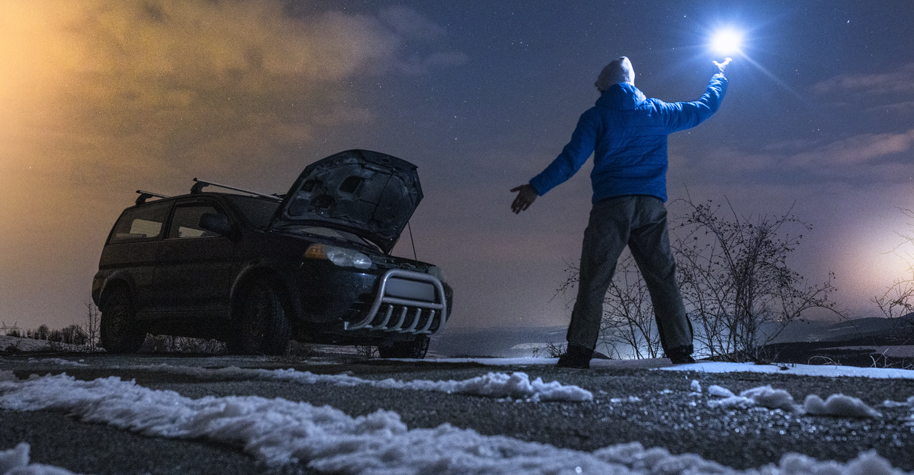#PrepYourHealth to Drive During Winter
Posted on by
Winter is here, and it’s not alone. It comes bearing weather that can make it dangerous to travel. Driving in wintery conditions such as snow, freezing rain, and ice puts drivers at increased risk of car crashes.(1)
About 21% (or 1,235,000) of the over 5,891,000 vehicle crashes each year are weather-related. Most weather-related crashes happen on wet pavement (70%) and during rainfall (46%). A smaller but no less significant number of them occur during snow or sleet (18%), on icy pavement (13%), and on snowy or slushy pavement (16%).(2)
Over 70% of the nation’s roads are in regions that average more than five inches of annual snowfall. Almost 70% of the U.S. population lives in these regions.(3)
If—like most of the U.S. population—you live somewhere that experiences winter weather, be prepared to drive (or not drive) in it.
Driving in the Snow
Driving in winter weather has its challenges. Snow, freezing rain, ice, and below-freezing temperatures can affect driving conditions. Here are some things to consider before and remember after you get behind the wheel.
- Know before you go. Call 511 or check your state’s department of transportation webpage to check road conditions. The best way to stay safe when driving in snow is not to. Only go out in winter weather if necessary. Avoid non-essential travel when the National Weather Service issues an advisory.
- Clean off your car before driving. Flying snow from cars can limit your visibility and the visibility of other drivers. Limited visibility can cause crashes.
- Follow the everyday rules of the road. Do not text or drive distracted; obey posted speed limits; wear your seat belt; and always drive sober.
- Slow down to improve your traction when driving on snow or ice. Remember “Ice and snow, take it slow.” Avoid traveling on ice-covered roads, overpasses, and bridges if possible.
- Put extra space between you and other drivers. Increase your following distance from 3-4 seconds to 5-6 seconds. It takes longer to slow down and stop on icy roads.
Snowplows are a common sight on roads and highways during and after a winter storm. They travel slowly, make wide turns, stop often, overlap lanes, and exit the road frequently. If you find yourself driving behind a plow, keep your distance. Don’t crowd the plow.
Roadside Emergency Kit
Prepare as if a roadside emergency will happen to you. Pack a roadside emergency kit that includes the items you need to handle travel delays like a flat tire and more serious roadside emergencies. A kit should include:
- Food and water
- Emergency lighting (e.g., flashlight or headlamp) and batteries
- Car and portable chargers for your cellphone
- First-aid supplies
- Warm clothes, blankets, and sleeping bags
- Spare tire, jack, and lug wrench
- Jumper cables and safety glasses
- Emergency hammer and seat belt cutter
- Road flares
- An ice scraper, folding shovel, and brush
Go beyond the basics by including these items in your roadside emergency kit:
- A portable carbon monoxide (CO) detector
- A road map or atlas
- A whistle to signal for help
- Sanitation and personal hygiene items
- Multi-purpose tool
Add other supplies based on your personal needs.
What to do If You’re Stranded
Winter storms can leave you stranded. Last year, a snowstorm trapped motorists in their vehicles on Interstate 95 for more than a day. (4) If you become stalled in or stranded by winter weather, stay focused on yourself and your passengers, your car, and your surroundings.
- Stay with your vehicle.
- Make yourself visible to rescuers:
- Turn on the dome light at night when running the engine.
- Tie a bright-colored cloth, preferably red, to your antenna or door.
- Raise the hood of your car if it’s not snowing.
- Wrap your entire body, including your head (without obstructing your breathing), in layers of clothing, blankets, and sleeping bags to prevent hypothermia. Hypothermia (abnormally low body temperature) is a dangerous condition that can happen when a person is exposed to extremely cold temperatures.
- Run the engine for about 10 minutes per hour to run the heater and charge your cellphone. Open a window slightly to let fresh air in and avoid carbon monoxide (CO) poisoning.
- Keep the exhaust pipe clear of snow to prevent CO poisoning.
Learn more about staying safe before and after a winter storm.
Resources
- Preparing for a Winter Storm
- Winter Weather Driving Tips (NHTSA)
- Winter Safety (NWS)
- Winter Weather Safety Social Media Toolkit (FEMA)
References
- https://policyadvice.net/insurance/insights/winter-driving-statistics/
- https://ops.fhwa.dot.gov/weather/q1_roadimpact.htm
- https://ops.fhwa.dot.gov/weather/weather_events/snow_ice.htm
- https://apnews.com/article/snow-storm-weather-195-virginia-660346cff578c655186ac517fb45f17f
Thanks in advance for your questions and comments on this Public Health Matters post. Please note that CDC does not give personal medical advice. If you are concerned you have a disease or condition, talk to your doctor.
Have a question for CDC? CDC-INFO (https://www.cdc.gov/cdc-info/index.html) offers live agents by phone and email to help you find the latest, reliable, and science-based health information on more than 750 health topics.


Post a Comment